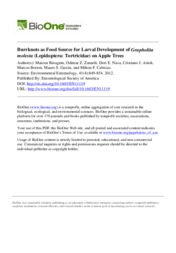Burrknots as food source for larval development of Grapholita molesta (Lepidoptera: Tortricidae) on apple trees.
Burrknots as food source for larval development of Grapholita molesta (Lepidoptera: Tortricidae) on apple trees.
Author(s): BISOGNIN; ZANARDI, Z. O.; NAVA, D. E.; ARIOLI, J. C.; BOTTON, M.; GARCIA, S. M.; CABEZAS, F. M.
Summary: Grapholita molesta (Busck) is one of the main pests of apple trees, and lives on their shoots and fruits. In southern Brazil, the insect is also found on old branches and structures similar to aerial roots, so-called burrknots. This study evaluated the development and population growth potential of G. molesta fed on burrknots, compared with apple fruit cultivar. Fuji and a corn-based artiÞcial diet. The study was carried out in the laboratory under controlled temperature (25 1C), relative humidity (7010%), and photophase (16 h). The biological parameters of the immature and adult stages were determined, and a fertility life table was constructed. Insects fed on burrknots showed a longer duration and a lower survival for the egg-to-adult period (29.3 d and 22.5%) compared with those that fed on apples (25.1 d and 30.0%) and artiÞcial diet (23.9 d and 54.8%). Insects reared on aerial roots had a lower pupal weight (10.0 mg) compared with those reared on either artiÞcial diet (13.7 mg) or apple cultivar. Fuji (12.4 mg). The fecundity and longevity of males and females did not signiÞcantly differ for the three foods. Based on the fertility life table, insects reared on burrknots had the lowest net reproductive rate (Ro), intrinsic rate of population growth (rm) and finite rate of increase, compared with insects reared on artiÞcial diet and apple fruit. Burrknots support the development of the complete cycle of G. molesta, which allows populations of this pest to increase in orchards.
Publication year: 2012
Types of publication: Journal article
Unit: Embrapa Grape & Wine
Keywords: Burrknots, Controle, Fertilidade, Fruticultura, Grapholita Molesta, Inseto, Lagarta, Mariposa Oriental, Maçã, Praga de planta
Observation
Some of Embrapa's publications are published as ePub files. To read them, use or download one of the following free software options to your computer or mobile device. Android: Google Play Books; IOS: iBooks; Windows and Linux: Calibre.
Access other publications
Access the Agricultural Research Database (BDPA) to consult Embrapa's full library collection and records.
Visit Embrapa Bookstore to purchase books and other publications sold by Embrapa.

